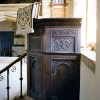In purely archaeological terms the Prehistoric constitutes the period un-represented by any written record, from when the country was first occupied by man right up to the Roman invasion. Dorset is especially well endowed in this regard. It is as if its topography, climate and geographical position were most highly coveted by the earliest settlers of southern England, and the concentration of their activities and monuments here attains a density unparalleled anywhere in the country. This understandably makes the workload of the county’s archaeology department particularly challenging, for most fieldwork today is salvage or “rescue” archaeology in the vanguard of development.
As elsewhere the prehistoric in Dorset had been organised into five distinct periods on the basis of the type of monument, pottery and other artefacts. Chronologically there were the Palaeolithic, Mesolithic, Neolithic, Bronze Age and Iron Age, collectively spanning the period from before 500 thousand years ago to 43 AD. Of these the first two periods alone covered approximately 496 thousand years, or 99% of the time Britain has been inhabited. These were illiterate periods of hard and short hunter-gatherer living almost entirely represented today by flint tools, bones, or cave art. One site in Dorset above all others, which has yielded evidence of flint working, has been Hengistbury Head.
About 4000 BC a possible dissemination of ideas and practices through contact with the continent brought agriculture to the inhabitants of Britain. This brought with it a more settled way of life, which in turn led to the first appearance of earthworks to define the areas of places established for religion, trade, tribal meeting or even settlement. Several distinct kinds of earthwork make their appearance in Dorset, namely Causewayed Enclosures, Long Barrows and Henges.
Causewayed enclosures are circular or irregularly oval areas defined by up to three ring-ditches accompanied by low banks or ramparts built up using spoil from the ditches. The banks are discontinuous in one or more places to allow access into the enclosure. The ditches have yielded most of the period’s flint tools, bones and sherds of the earliest pottery to be made in England, clearly indicating that the people were habitually using ditches as middens for the refuse from their settlements, whether these were situated within the enclosures or outside them. Elsewhere excavation of some ditches has yielded only human remains, suggesting that at these enclosures only funeral rites were practised.
Causewayed enclosures are mainly distributed on the hilltops of the chalk downland, though some may have been constructed in the wider valleys. Two notable examples are at Dorchester: Flagstones was a causewayed enclosure partly destroyed by the construction of the town’s bypass; the remainder actually lies beneath Maxgate, the home of Thomas Hardy. This site revealed the marks of the antler picks used to dig it, and some burials took place in and around the enclosure. The hillforts of Maiden Castle near Dorchester and Hambledon Hill began their prehistoric record as causewayed enclosures before these were abandoned or superseded by later earthworks.
Long Barrows were or are the earthen prehistoric equivalent to mausolea for communal burial. They can be over 90 metres (300 feet) long, and usually taper towards the end, both in plan and elevation. The majority had a wooden mortuary enclosure and ditches usually flanked the sides. They are generally a feature of the chalk uplands, with two major groupings around and to the west of Dorchester. There are also groups on Pimperne and Thickthorn Downs near Cranbourne, close to the south west end of the special contemporary earthwork known as the Dorset Cursus. The Hell Stone near Portesham is the stone cairn of a long barrow now worn away.
A special class of barrow (and one found nowhere else outside Dorset) is the Bank Barrow, a much elongated variant of the long barrow, but which did not usually enclose a burial. There are three of these earthworks: at Maiden Castle and Came Down near Dorchester and at Martins Down near Long Bredy.
The Dorset Cursus itself was a linear enclosure almost 7 miles long, defined by two sets of parallel banks and ditches. It runs from Thickthorn Down to Pentridge, though only at the later does any part of the earthwork survive today. Its function is a matter of some controversy, though the monument probably reflects an aspect of tribal ritual. Associated long barrows cut the cursus at two points, showing that the burials were later, from a time when the cursus had passed out of use.
The transition from the Neolithic to the Bronze Age was not a sudden event, but a slow process of social and demographic change, which went on roughly between 2,500 and 1,500 BC. Over this period the causewayed camps were abandoned and the long barrows were sealed. During this phase also, the exclusively British innovation of the Henge makes its appearance.
Henges differed from the causewayed enclosures in usually having only one bank with entrances and the ditch usually, though not invariably, on the inside. The interiors were often left without other structures, though some had pits, posts, or standing stones. Mount Pleasant and Maumbury Rings near Dorchester and Eggardon Hill near Winterbourne Abbas being the best examples. Mount Pleasant was 400 metres (450 yards) across and was a major tribal centre with rings of timber uprights inside, though today it is only visible as an earth mark in the chalk soil. Henges usually occur singularly, but at Knowlton near Gussage St. Michael there is a cluster of three or four in close association.
Close to the henges in time were un-enclosed Stone Circles, which may reflect on a smaller scale the function of the more complex monument. There are two examples of these in Dorset, at Kingston Russell near Abbotsbury and Nine Stones near Winterbourne Abbas.
By far the most prolific (and most important) source of the information and artefacts of the Bronze Age Beaker and Wessex Cultures are the Round Barrows. There were six variants on the basic plan, Bell and Bowl Barrows being the most common. Wessex was the heartland of barrow building and there are still some 400 surviving examples to be seen along the South Dorset Ridgeway. They were graves of a rich chiefdom society and have yielded rich hoards of pottery, brooches, and gold and bronze objects, as at Clandon near Martinstown. There are large cemeteries at Oakley Down near Sixpenny Handley and at Poor Lot near Winterbourne Abbas. Further clusters occur around the Dorset Cursus, in Came Wood and around the Knowlton henges.
After 1000 BC there were permanent fields and settlement sites. Around 700 BC the Iron Age in Britain began, when population pressure and increasing inter-tribal warfare may have been the impetus for the appearance of the great revetted and defended hillforts. The earliest in Dorset may be Chalbury near Weymouth (c.600 BC.) Between 200 and 100 BC many of these forts were much enlarged, as at Maiden Castle, Eggardon Hill, Hod Hill, Hambledon Hill, Badbury Rings, Abbotsbury Castle, Pilsden Pen and Rawlesbury.
But the present distribution of these monuments can be misleading as to the pattern of settlement in prehistoric Dorset. Because the monuments and settlements are today found only on the uplands it has been thought that the people of the time only settled and farmed here. But later people have not used the higher ground intensively. It has now been realised that the valleys were settled in prehistoric times also, but here the evidence of activity has largely been destroyed by post-Roman settlement and farming.



